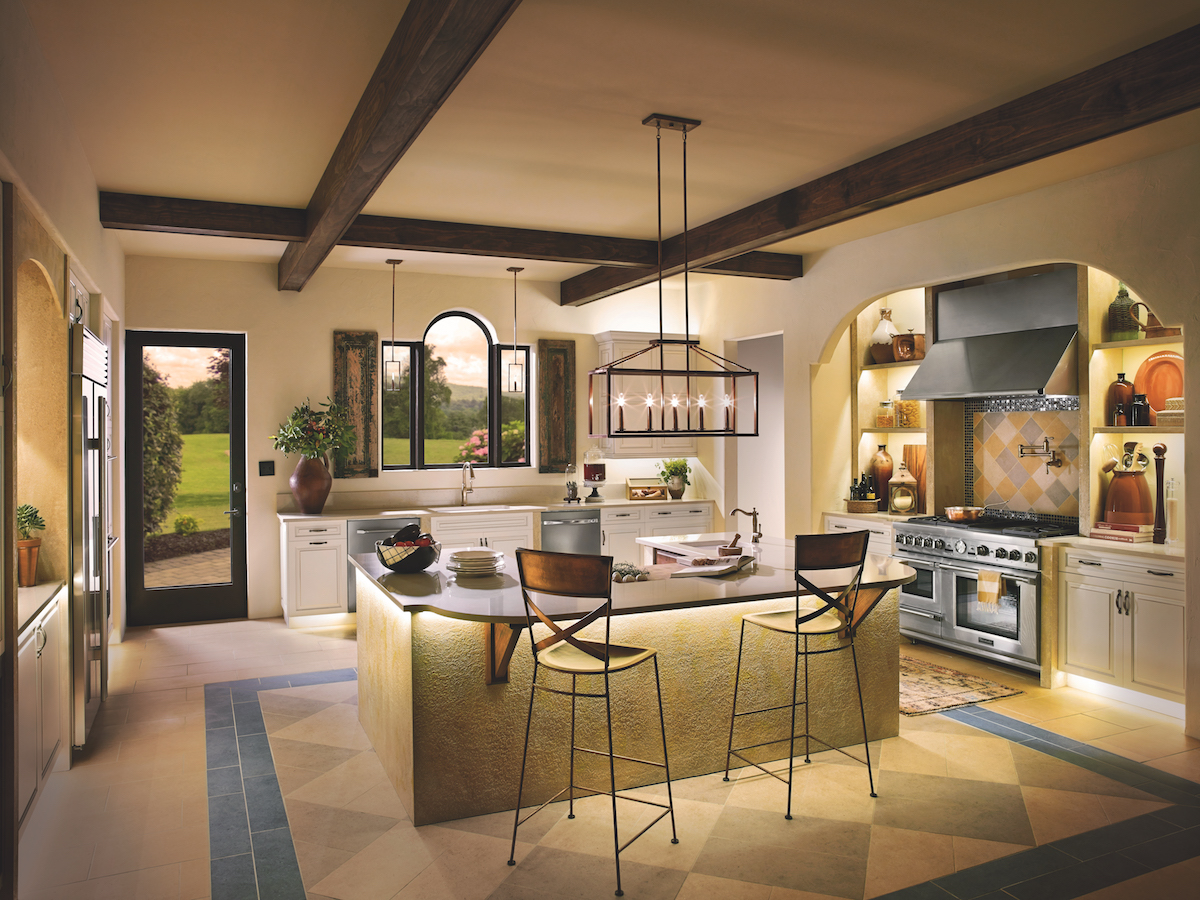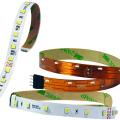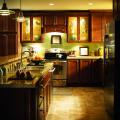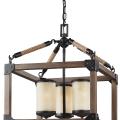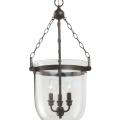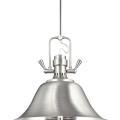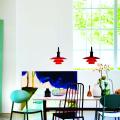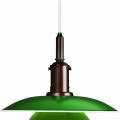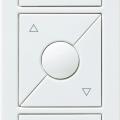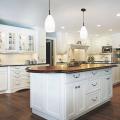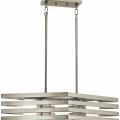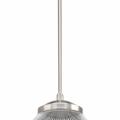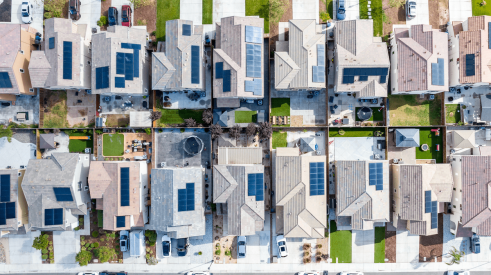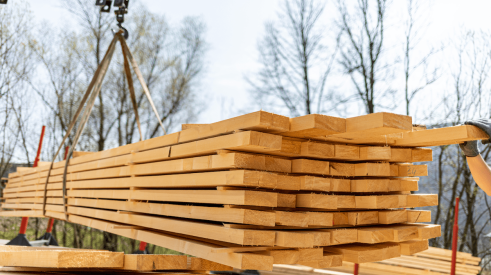The latest in kitchen lighting offers builders plenty of stylish fixture options at every price point, and sophisticated controls that work remotely from a smartphone or tablet. As important, fixture manufacturers are expanding their lines for compact fluorescent (CFLs) and light-emitting diode (LEDs) bulbs, which are demanded by some local codes as well as homeowners.
“Consumers are more savvy,” says Clint Thompson, residential and builder manager at Alloway Lighting Co., in Boise, Idaho. “They want energy-efficient lighting.”
Focus on Fixtures
Decorative pendants remain the fixture of choice over islands and peninsulas for many production builders. “Pendant lights…have become very popular in all styles—traditional to modern,” says Liz Friedman, design studio manager for Beazer Homes’ Maryland/Delaware division. Plus, she adds: “Our islands are getting larger and longer, and the pendants provide good task lighting as well as adding style to the kitchen.”
Oversized decorative pendants are growing in popularity with homeowners. “Now 20 inches is not uncommon for a fixture, and even two or three of them over an island,” says Brian Lintner, director of product development and design for Sea Gull Lighting. “It’s what (consumers) are seeing in kitchens in commercials and TV programs.”
Three-light chandeliers and pendants still are the norm over the table in production homes, with the most decorative pieces adding “visual sparkle” to the space, says Randall Whitehead, a California-based lighting designer. Drum-shaped fixtures are gaining ground because of their clean looks, and manufacturers are applying lenses to their bottoms to hide less-attractive CFLs and LEDs, he says.
Other kitchen fixture-style trends include industrial-look pieces in iron, copper, bronze, or wood that purposely clash with appliance finishes, and lanterns that mimic exterior fixtures, Lintner says.
Brushed nickel and oil-rubbed bronze are the top finishes throughout production homes, although designers say chrome kitchen fixtures are also back in vogue. Beazer Homes Maryland/Delaware is experiencing some demand for chrome, Friedman says. But that’s not true for all builders. “We haven’t seen it yet in our market,” says Courtney Baur, designer for Dream Finders Homes in Orange Park, Fla. “It’s trendier, and we have more traditional buyers.”
Lighter gold tones and bronze finishes also are moving into the kitchen, notes Jeffrey Doss, Kichler’s corporate director of education and industry trends. And sometimes all at once. Whitehead says finishes don’t have to match—a popular trend in home décor—and builders can mix nickel, stainless steel, pewter, and other metals with blacks, grays, and whites to create unique looks.
Under-cabinet lighting remains a favorite of cooks, and adding puck, linear, and tape strips, which now are available in multiple lamp technologies, is easy and cost-effective. “Under-cabinet lighting is a simple upgrade that can make a big difference in kitchen settings,” says Todd Roy, Progress Lighting’s national sales director.
Lighten Up
Energy-efficient CFLs are standard throughout many new houses, especially Energy Star-rated homes or those built to other green building program standards. Federal government regulation forced the phase-out of traditional A-style 100-, 75-, 60- and 40-watt incandescent lamps in recent years, so builders had to incorporate more efficient technologies. (60-and 40-watt bulbs are available until existing supplies run out. Halogen incandescents still are available.)
“CFLs last much longer than incandescents and produce 75 percent less heat,” notes Ashley Crews, design center manager for Goodall Homes, which installs CFL fixtures and incandescent under-cabinet lights in its Nashville-area homes. The Department of Energy reports that Energy Star-rated CFLs last 10 percent longer and use 25 percent less energy than A-type incandescents, and LEDs last 25 percent longer and use 25 percent less energy.
Nevertheless, CFLs cost more than incandescents, don’t provide a full-color spectrum, and lose brightness over time. Some CFLs can’t be dimmed, and dimmable ones don’t dim well when used with incandescent-specific dimmers. Manufacturers are now starting to produce dimmers specifically for CFLs and LEDs. Plus, in some areas, broken and burned out CFLs must be taken to recycling centers or retailers or mailed back to manufacturers because they contain mercury.
Designers and manufacturers are encouraging builders to step up to LEDs, which offer longer lifespans, brighter light, and better color consistency than CFLs. LEDs also don’t contain mercury, so they don’t have disposal requirements. And, fixture manufacturers are rapidly expanding their LED offerings.
LEDs are “not that much more of an investment, they’re dimmable, there are no heat issues, and the light looks great,” Thompson says. “They will enable builders to set themselves apart from other builders.”
As usage has gone up, screw-in LED costs have dropped to CFL price levels. Meanwhile, a number of utilities that offer LED rebates to consumers are expanding those rebates to home builders.
A Slow Transition
Some builders have made the switch to LEDs, but only in a few models. For instance, Beazer Homes, Maryland/Delaware, installs LED recessed lighting in its condo kitchens, and Dream Finders Homes uses LED recessed cans in its higher-end Platinum Series dwellings.
“People were asking for them, and pricing was only a little bit more than our base lighting kit,” Baur says.
Nevertheless, LEDs only represent a small portion of the residential lighting market, and even in California, which mandates ultra-efficient lighting, use is still limited, notes Doss.
So for now, many builders are sticking with incandescents. “The overwhelming demand still is for incandescent fixtures because they remain the least expensive option,” Lintner says, noting it costs $5 per socket more to step up to a CFL or LED lamp.
Besides, a lot of buyers are more interested in other upgrades. “A majority of our customers are looking for a good-quality home in a good location,” says David Erickson, president of Grayhawk Homes, which builds in Georgia and Iowa. “Once they get that, then they are looking for nicer cabinets, flooring, and countertops.”
Dim it Down
A lot of production builders offer dimming controls standard in some rooms, but not always in the kitchen. Manufacturers say affordable technologies are available, but many builders aren’t aware of all the options. “It’s not just for the wealthy” anymore, says David Weinstein, Lutron’s vice president of residential sales.
Wireless controls, such as Lutron’s Caséta, allow owners to adjust lights, shades, and room temperatures from their smartphones or tablets—inside or outside their homes. “You can open the app and see if you left the lights on,” says Weinstein, who predicts the next generation of controls will be wireless.
Whitehead notes that LEDs look more like incandescents when dimmed, another plus for the highly efficient bulbs.
Down the road, Doss predicts that all switches in the home will be operated from one central point, such as a computer or mobile device. But, he adds, new kitchens are likely to have separate switches controlling recessed cans, under- and inside-cabinet lighting, pendants, and more, so dimming will be less important. PB
Advertisement
Related Stories
Sustainability
Mention of Eco-Friendly Home Features Is on the Rise in Sales Listings
Home listing descriptions using eco-friendly terms have been rising over the past five years in line with growing consumer interest in the environment and energy efficiency
Design
What Gen-Z Buyers Really Want in a Home
The fervor of planning for Millennials in the home building industry has now pivoted to Gen Z. So, what does this new generation want?
Building Materials
Lumber Leads Building Materials Prices Higher in March
Overall, the cost of building materials rose during March, with softwood lumber, gypsum products, and concrete all seeing price increases. Only steel mill materials saw price drops


